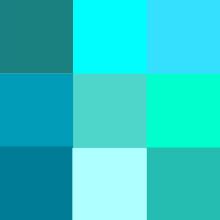Wavelength 490–520 nm Hex triplet #00FFFF CMYK (c, m, y, k) (100, 0, 0, 0) | Frequency 610–575 THz sRGB (r, g, b) (0, 255, 255) HSV (h, s, v) (180°, 100%, 100%) | |
 | ||
Cyan (/ˈsaɪ.ən/ or /ˈsaɪ.æn/) is greenish-blue color. It is evoked by light with a predominant wavelength of between 490–520 nm, between the wavelengths of blue and green.
Contents
- Etymology
- The web colors cyan and aqua
- Process cyan pigment cyan printers cyan
- Color of water
- Cyan and cyanide
- Bacteria
- Astronomy
- Energy
- Photography and film
- Medicine
- Surgeons gowns
- References
In the subtractive color system, or CMYK (subtractive), which can be overlaid to produce all colors in paint and color printing, cyan is one of the primary colors, along with magenta, yellow, and black. In the additive color system, or RGB (additive) color model, used to create all the colors on a computer or television display, cyan is made by mixing equal amounts of green and blue light. Cyan is the complement of red; it can be made by the removal of red from white light. Mixing red light and cyan light at the right intensity on a black screen will make white.
The web color cyan is synonymous with aqua. Other colors in the cyan color range are teal, turquoise, electric blue, aquamarine, and others described as blue-green.
Etymology
Its name is derived from the Ancient Greek κύανος, transliterated kyanos, meaning "dark blue". It was formerly known as "cyan blue" or cyan-blue, and its first recorded use as a color name in English was in 1879. Further origins of the color name can be traced back to a dye produced from the cornflower (Centaurea cyanus).
In most languages, 'cyan' is not a basic color term and it phenomenologically appears as a greenish vibrant hue of blue to most English speakers. Reasons for why cyan is not linguistically acknowledged as a basic color term can be found in the frequent lack of distinction between blue and green in many languages.
The web colors cyan and aqua
The web color cyan shown at right is a secondary color in the RGB color model, which uses combinations of red, green and blue light to create all the colors on computer and television displays. In X11 colors, this color is called both cyan and aqua. In the HTML color list, this same color is called aqua.
The web colors are more vivid than the cyan used in the CMYK color system, and the web colors cannot be accurately reproduced on a printed page. To reproduce the web color cyan in inks, it is necessary to add some white ink to the printer's cyan below, so when it is reproduced in printing, it is not a primary subtractive color. It is called aqua (a name in use since 1598) because it is a color commonly associated with water, such as the appearance of the water at a tropical beach.
Process cyan (pigment cyan) (printer's cyan)
Cyan is also one of the common inks used in four-color printing, along with magenta, yellow, and black; this set of colors is referred to as CMYK as in spectrum(s).
While both the additive secondary and the subtractive primary are called cyan, they can be substantially different from one another. Cyan printing ink can be more saturated or less saturated than the RGB secondary cyan, depending on what RGB color space and ink are considered.
Process cyan is not an RGB color, and there is no fixed conversion from CMYK primaries to RGB. Different formulations are used for printer's ink, so there can be variations in the printed color that is pure cyan ink. This is because real-world subtractive (unlike additive) color mixing does not consistently produce the same result when mixing apparently identical colors, since the specific frequencies filtered out to produce that color affect how it interacts with other colors. A typical formulation of process cyan is shown in the color box at right.
